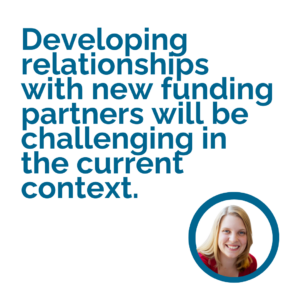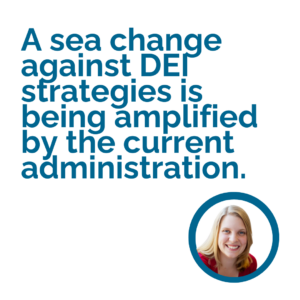For many nonprofits, federal grants and contracts are just one part of their larger revenue profile. With the news to date this year dominated by updates regarding reductions in federal funding, little advice is available about how policy change at the federal level contributes to changes in private funding priorities and availability.
In early 2025 Elevate hosted a three-part Conversation Series on Navigating Uncertainty in the Funding Landscape. The first of these – But what about private grants? – covered our responses to 5 questions Elevate’s nonprofit partners have asked about their private foundation grant strategy in the context of uncertainty around federal funds.
This article provides highlights from the Conversation Series session, including the questions, key considerations, and Elevate’s advice for nonprofit leaders.
Question #1: If we lose public funding for our programs, can we replace it with increased support from foundations or corporations?
If your federal grants or contracts are rescinded or ended, it is unlikely that you will be able to replace that funding with private support.
 First, there is far more public funding than private funding. In 2023, the federal government provided $303 billion in grants and contracts to nonprofits, whereas private foundations award around $107 billion annually to U.S. nonprofits. It is not reasonable to expect that private philanthropy could “step up” and fill this gap.
First, there is far more public funding than private funding. In 2023, the federal government provided $303 billion in grants and contracts to nonprofits, whereas private foundations award around $107 billion annually to U.S. nonprofits. It is not reasonable to expect that private philanthropy could “step up” and fill this gap.
Instead, private philanthropy is likely to get more competitive in a period of constrained resources. We expect that more organizations will be appealing to foundations for limited private funds, and that grantmakers may opt to focus their own limited resources on supporting those organizations with whom they already have relationships.
Second, private funders are unlikely to prioritize filling the gap created by a loss of public funding. Philanthropy sees their role as distinct from the public sector. Private grantmakers are more likely to be interested in opportunities to build capacity, test new ideas, and establish the evidence for what works, whereas public funding is often leveraged to support direct programmatic services. What’s more, private funders who want to demonstrate resistance to the current administration do not want to step into this gap because it takes the pressure off of the government to play their part.
At the end of the day, there is simply no equivalency between public and private funding and one cannot build effective fundraising strategies that assume private funders will simply “step up” where public funding is declining.
Question #2: What can I do today to shore up my existing private funding streams?
We all care a lot about the work we do and the communities we work with, so it can be hard to discuss the possibility that we will have to navigate a period of fewer resources and less support for the communities we serve. So, what can nonprofit leaders do now?
 First, talk with your funding partners. Foundations and corporations rely on their grantees to tell them about community needs – it’s why nearly every grant proposal requires you to define the need you are addressing. When things are changing quickly, as they are now, grantmakers have less insight than you do about whether the need is increasing, decreasing, or just changing. Be proactive – don’t wait for your funders to ask. Reach out to make them aware of what’s happening at your organization and offer to be a resource to funders who want to be part of the conversation.
First, talk with your funding partners. Foundations and corporations rely on their grantees to tell them about community needs – it’s why nearly every grant proposal requires you to define the need you are addressing. When things are changing quickly, as they are now, grantmakers have less insight than you do about whether the need is increasing, decreasing, or just changing. Be proactive – don’t wait for your funders to ask. Reach out to make them aware of what’s happening at your organization and offer to be a resource to funders who want to be part of the conversation.
As we saw during COVID-19, the foundations and corporations who already know and trust your work are those you can go to first and most easily when the community needs are changing. Because you have already made the case to them, they already know the needs your organization addresses, and you can focus on updating them on how things are changing in the current context.
Similarly, when the future is highly uncertain, it is harder for philanthropists to invest in new grantees. Many grantmakers will opt to increase funding for their current grantees who are reaching out with requests for additional support. Others may not have the capacity to get to know new organizations and the needs they address while the foundation itself is reworking its own priorities in a period of change. Developing a new funding relationship is never easy, and it will likely be even more challenging in the current context.
Question #3: How do I talk to my funding partners about all of this?
Your donors are going to be hearing from all of their grantees – plus organizations seeking new support – during this time of uncertainty. The calls for additional support will be coming from all sides, and you’ll have to work even harder now to stand out from the crowd.
 Keep in mind that the best practices of cultivation and stewardship still apply: keep in touch with your donors, update them about your work, and offer to be a resource to them about what is happening on the ground.
Keep in mind that the best practices of cultivation and stewardship still apply: keep in touch with your donors, update them about your work, and offer to be a resource to them about what is happening on the ground.
Start by asking questions. What are foundation leaders thinking about and grappling with themselves at this time? How can you – as a community leader – help them understand the impact of the Executive Orders and other federal actions on your organization and your community? Use what you know about the funder’s history of giving, the concerns they share, and the relationship you’ve built to be explicit about how you are aligned.
Be specific about the ways your organization is being impacted. Have you lost important sources of funding? Are you concerned about possible legal actions? Are the people you serve at risk of losing rights or services? How can private funding make a real difference for the community you serve or for whom you advocate in this context?
Finally, while making the case for the need for funding, what positive news can you share about how your organization has prepared to navigate the weeks, months, and years ahead that will give your funders a sense that continued (or increased!) funding is a good investment? What leadership expertise, financial strategies, or planning do you have in place to support your organization’s ability to navigate difficult circumstances? In other words, make your request from a position of strength, rather than from a position of distress or alarm.
Question #4: Should we change how we talk about our DEI work?
The backlash against Diversity, Equity, and Inclusion efforts makes many feel unsafe, while others may feel disheartened by the clash between the discourse and their own values.
 The efforts to dismantle DEI in philanthropic and nonprofit sectors predates the recent Executive Orders. Our colleague, Johnisha Levi, published an informative and well-researched article last year highlighting the impact of the June 2023 Supreme Court decision, which found that Harvard’s “race conscious” admissions violated the Constitution. This was the beginning of a significant sea change against affirmative action and other DEI strategies that is now being amplified by the current administration.
The efforts to dismantle DEI in philanthropic and nonprofit sectors predates the recent Executive Orders. Our colleague, Johnisha Levi, published an informative and well-researched article last year highlighting the impact of the June 2023 Supreme Court decision, which found that Harvard’s “race conscious” admissions violated the Constitution. This was the beginning of a significant sea change against affirmative action and other DEI strategies that is now being amplified by the current administration.
While the anti-DEI Executive Orders are challenged in court, public and private institutions find themselves in limbo.
If you receive direct federal funding, you have likely already received instructions from the granting agency on what will need to change about how you talk about your work or about the work you actually do with your grant funds. If you receive pass-through funding, the guidance may come later as the information trickles down to sub-grantees.
While they receive these notices about their federal grants, many of our clients have asked whether they should be taking similar steps to change the language around DEI in their private grant applications.
We caution against making dramatic changes to how you talk about your work until you know more about each foundation or corporate funder’s stance. There will likely be some grantmakers that will increase their support of organizations working with immigrants, supporting the LGBTQIA+ community, or advancing race equity in their communities. Others may take a more conservative approach.
At this time, most private and corporate funders have not had a chance to change their application templates, so they will continue to ask for demographic information about the community you serve, your staff and board, and other details. You should still fill that information out as accurately as possible.
Question #5: How do I plan for the future?
The past 5 years have been a historically hard time to lead a nonprofit, and a key reason for that is the pressure that comes from knowing that people rely on the work you do to meet their basic needs, learn and grow, maintain or improve their health, access employment and opportunities that benefit their families, and more.
 Considering a future where you have fewer resources and are thus less able to do this important work can be overwhelming.
Considering a future where you have fewer resources and are thus less able to do this important work can be overwhelming.
At this point, our advice is to:
- Focus on What Matters Most: What is your unique and essential contribution to your community? This is what you prioritize over everything else.
- Phone a Friend (or Many Friends): Call that extra board meeting. Gather information from your community advisory board. Talk to your staff, beneficiaries, and partners to understand what they need, what they can offer, and how you can work together.
- Plan for Multiple Futures: Where is your funding coming from? What does your financial picture look like if one funding stream disappears? What does it look like if some but not all of your private/corporate funding continues?
Explore other resources and insights from the Navigating Uncertainty series:
About the Author:

President & Managing Director










 First, there is far more public funding than private funding.
First, there is far more public funding than private funding.  First, talk with your funding partners. Foundations and corporations rely on their grantees to tell them about community needs – it’s why nearly every grant proposal requires you to
First, talk with your funding partners. Foundations and corporations rely on their grantees to tell them about community needs – it’s why nearly every grant proposal requires you to  Keep in mind that the
Keep in mind that the  The efforts to dismantle DEI in philanthropic and nonprofit sectors predates the recent Executive Orders. Our colleague, Johnisha Levi, published
The efforts to dismantle DEI in philanthropic and nonprofit sectors predates the recent Executive Orders. Our colleague, Johnisha Levi, published  Considering a future where you have fewer resources and are thus less able to do this important work can be overwhelming.
Considering a future where you have fewer resources and are thus less able to do this important work can be overwhelming. 




